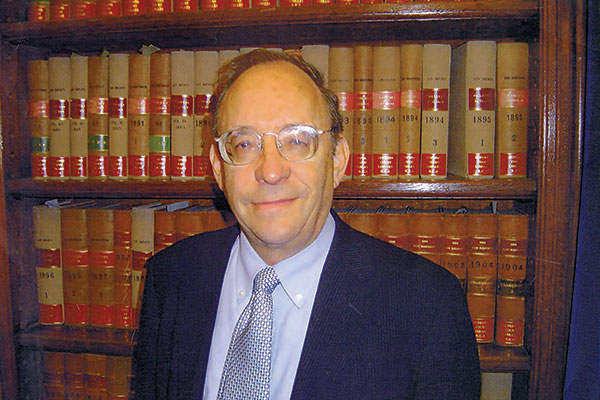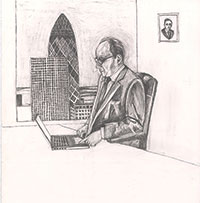*/

Sir Gavin Lightman passed away on 2 March 2020, six months after being diagnosed with an inoperable brain tumour. He was called to the Bar in 1963, took silk in 1980 and was appointed as a High Court judge in 1994. After his retirement from the Bench in 2008, he was Treasurer of Lincoln’s Inn for the year 2008-2009. It is a reflection of his deeply held belief in the importance of justice that the motto (in Hebrew) which he chose for his coat of arms which is on the wall of Lincoln’s Inn’s Great Hall was Im Ain Mishpat Ain Shalom, which may be translated as ‘Without law, there can be no peace’.
Gavin Lightman was born in London in 1939, at a time when the poison of anti-Semitic hatred was all too prevalent. His father, Harold Lightman QC, was one of the first Jews to head chambers, at 13 Old Square, Lincoln’s Inn. Gavin was sent to boarding school aged just 2½, and experienced bullying. No doubt his passion for justice was heavily informed by these experiences. He attended Dulwich College and then read law at UCL, where his was the only First awarded in 1961.
Gavin won a Fulbright Scholarship to do an LLM at the University of Michigan and thereafter taught land law for a year at the University of Sheffield. He also taught land law at Merton College, Oxford, and, together with Gabriel Moss QC, he co-authored the seminal text Lightman & Moss on the Law of Administrators and Receivers of Companies (now in its sixth edition). His clients at the Bar were often high-profile and the range of his work was wide and varied. He represented the National Union of Miners during the Miners’ Strike in 1984-1985, and became friendly with Arthur Scargill. Nevertheless, he did not shirk from criticising Scargill in his report, for which he was chosen by the Haldane Society, in 1990 concerning mishandling of cash donations during the Miners’ Strike. In 1989, he saved Private Eye from almost certain closure by successfully arguing for a reduction of the £600,000 damages award to £60,000 in favour of Sonia Sutcliffe, the wife of the so-called Yorkshire Ripper. He also undertook cases in the courts of Barbados, Bermuda, Singapore and Hong Kong.
I appeared against Gavin at the beginning of my practice when he acted for the government against financial advisers in the Barlow Clowes civil litigation. Thereafter I appeared in front of him as Treasury Counsel in the Administrative Court, as well as otherwise in Chancery cases. After his retirement he was part of the arbitral tribunal on a shipping matter in which I appeared as counsel.
One of his former opponents, Lord Neuberger, later the President of the UK Supreme Court, described Gavin as ‘fearless, clear and speedy. If he was my opponent, I would always do that extra bit of preparation the night before the case was due to start’. Lord Briggs of Westbourne said of Gavin ‘quite simply, the best chancery lawyer I have ever known. Both as a judge and as a barrister he had an assured sense of the right legal principle to apply to any fact situation that presented itself… Throughout our time in chambers together I regarded him as my mentor and friend. He gave freely of his time, wisdom and loving kindness.’
It was (and is rare) for sitting judges to go to print on their candid views of the legal system and access to justice. He was unafraid to do so, even if that may well explain in part why he did not advance (as his ability merited) beyond the High Court Bench.
In 1999, writing in the New Law Journal, he observed that: ‘The aim of the judge is by judicial intervention to promote justice by saving time and costs and concentrating on essential issues without any sacrifice of the principles of impartiality.’ In his article for the New Law Journal in 2004 ‘Litigation: the last resort’, he wrote: ‘In litigation there is only one winner – and that is generally the lawyer.’ He was characteristically unafraid to speak his mind in 2007 when he wrote in the Times: ‘The Government has been willing to spend millions on luxuries such as wallpaper, the Dome and the Olympic Games – but unwilling to fund access to justice. The dilemma, then, is how to provide the protection of the law to citizens who cannot pay.’
At a time when having the courage of one’s convictions, honesty and integrity are increasingly rare in public life, Sir Gavin Lightman’s life exemplifies those qualities.


Sir Gavin Lightman passed away on 2 March 2020, six months after being diagnosed with an inoperable brain tumour. He was called to the Bar in 1963, took silk in 1980 and was appointed as a High Court judge in 1994. After his retirement from the Bench in 2008, he was Treasurer of Lincoln’s Inn for the year 2008-2009. It is a reflection of his deeply held belief in the importance of justice that the motto (in Hebrew) which he chose for his coat of arms which is on the wall of Lincoln’s Inn’s Great Hall was Im Ain Mishpat Ain Shalom, which may be translated as ‘Without law, there can be no peace’.
Gavin Lightman was born in London in 1939, at a time when the poison of anti-Semitic hatred was all too prevalent. His father, Harold Lightman QC, was one of the first Jews to head chambers, at 13 Old Square, Lincoln’s Inn. Gavin was sent to boarding school aged just 2½, and experienced bullying. No doubt his passion for justice was heavily informed by these experiences. He attended Dulwich College and then read law at UCL, where his was the only First awarded in 1961.
Gavin won a Fulbright Scholarship to do an LLM at the University of Michigan and thereafter taught land law for a year at the University of Sheffield. He also taught land law at Merton College, Oxford, and, together with Gabriel Moss QC, he co-authored the seminal text Lightman & Moss on the Law of Administrators and Receivers of Companies (now in its sixth edition). His clients at the Bar were often high-profile and the range of his work was wide and varied. He represented the National Union of Miners during the Miners’ Strike in 1984-1985, and became friendly with Arthur Scargill. Nevertheless, he did not shirk from criticising Scargill in his report, for which he was chosen by the Haldane Society, in 1990 concerning mishandling of cash donations during the Miners’ Strike. In 1989, he saved Private Eye from almost certain closure by successfully arguing for a reduction of the £600,000 damages award to £60,000 in favour of Sonia Sutcliffe, the wife of the so-called Yorkshire Ripper. He also undertook cases in the courts of Barbados, Bermuda, Singapore and Hong Kong.
I appeared against Gavin at the beginning of my practice when he acted for the government against financial advisers in the Barlow Clowes civil litigation. Thereafter I appeared in front of him as Treasury Counsel in the Administrative Court, as well as otherwise in Chancery cases. After his retirement he was part of the arbitral tribunal on a shipping matter in which I appeared as counsel.
One of his former opponents, Lord Neuberger, later the President of the UK Supreme Court, described Gavin as ‘fearless, clear and speedy. If he was my opponent, I would always do that extra bit of preparation the night before the case was due to start’. Lord Briggs of Westbourne said of Gavin ‘quite simply, the best chancery lawyer I have ever known. Both as a judge and as a barrister he had an assured sense of the right legal principle to apply to any fact situation that presented itself… Throughout our time in chambers together I regarded him as my mentor and friend. He gave freely of his time, wisdom and loving kindness.’
It was (and is rare) for sitting judges to go to print on their candid views of the legal system and access to justice. He was unafraid to do so, even if that may well explain in part why he did not advance (as his ability merited) beyond the High Court Bench.
In 1999, writing in the New Law Journal, he observed that: ‘The aim of the judge is by judicial intervention to promote justice by saving time and costs and concentrating on essential issues without any sacrifice of the principles of impartiality.’ In his article for the New Law Journal in 2004 ‘Litigation: the last resort’, he wrote: ‘In litigation there is only one winner – and that is generally the lawyer.’ He was characteristically unafraid to speak his mind in 2007 when he wrote in the Times: ‘The Government has been willing to spend millions on luxuries such as wallpaper, the Dome and the Olympic Games – but unwilling to fund access to justice. The dilemma, then, is how to provide the protection of the law to citizens who cannot pay.’
At a time when having the courage of one’s convictions, honesty and integrity are increasingly rare in public life, Sir Gavin Lightman’s life exemplifies those qualities.



Chair of the Bar reflects on 2025
AlphaBiolabs has donated £500 to The Christie Charity through its Giving Back initiative, helping to support cancer care, treatment and research across Greater Manchester, Cheshire and further afield
Q&A with criminal barrister Nick Murphy, who moved to New Park Court Chambers on the North Eastern Circuit in search of a better work-life balance
Revolt Cycling in Holborn, London’s first sustainable fitness studio, invites barristers to join the revolution – turning pedal power into clean energy
Rachel Davenport, Co-founder and Director at AlphaBiolabs, reflects on how the company’s Giving Back ethos continues to make a difference to communities across the UK
By Marie Law, Director of Toxicology at AlphaBiolabs
Are you ready for the new way to do tax returns? David Southern KC explains the biggest change since HMRC launched self-assessment more than 30 years ago... and its impact on the Bar
Professor Dominic Regan and Seán Jones KC present their best buys for this holiday season
Marking one year since a Bar disciplinary tribunal dismissed all charges against her, Dr Charlotte Proudman discusses the experience, her formative years and next steps. Interview by Anthony Inglese CB
Little has changed since Burns v Burns . Cohabiting couples deserve better than to be left on the blasted heath with the existing witch’s brew for another four decades, argues Christopher Stirling
Pointillism, radical politics and social conscience. Review by Stephen Cragg KC